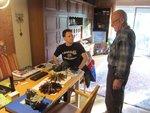Gixxerman
Senior Airman
Wow, some H2 owners here, nice. Always fancied one but never did.
I was ( am) mostly into Suzuki's. I love 2 strokes had all the Gts (except for the 750 triple, which a few friends had so I know them reasonably well). I took a while to get into 4 strokes but the big Gsx11's were ( currently the Gsxr11w) are my thing. Even the 80's Gsx11 weren't exactly the best handling bikes (all that weight basic physics) but the Gsxr's are so much better (more compact, lighter, much better suspension, brakes tyres - despite the power hike - make the big difference I think).
All a carb per pot, the earlier ones ran well enough (nothing quite like a well set up crisp 2 stroke hitting its power-band) but the later ones are harder to set up right but run extremely well at all speeds, the more recent bikes with fuel injection, digital ignition 'closed loop computerised control systems seem much easier to mess with (just get out your laptop, get a Dynojet Power Commander exhaust 'sniffer' when you put it on the rolling road)
I was ( am) mostly into Suzuki's. I love 2 strokes had all the Gts (except for the 750 triple, which a few friends had so I know them reasonably well). I took a while to get into 4 strokes but the big Gsx11's were ( currently the Gsxr11w) are my thing. Even the 80's Gsx11 weren't exactly the best handling bikes (all that weight basic physics) but the Gsxr's are so much better (more compact, lighter, much better suspension, brakes tyres - despite the power hike - make the big difference I think).
All a carb per pot, the earlier ones ran well enough (nothing quite like a well set up crisp 2 stroke hitting its power-band) but the later ones are harder to set up right but run extremely well at all speeds, the more recent bikes with fuel injection, digital ignition 'closed loop computerised control systems seem much easier to mess with (just get out your laptop, get a Dynojet Power Commander exhaust 'sniffer' when you put it on the rolling road)
Last edited:

